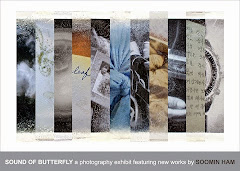
In SOUND OF BUTTERFLY, MEG member Soomin Ham’s current show, Soomin takes an experimental, yet personal, approach to seeing, understanding and interpreting memories of grief and loss. The series of portraits reflect her mother’s journey through life and death, and reveal traces of this journey as Soomin’s memories and vision uncover a deeper narrative beyond the images presented.
Below, Soomin answers a few questions about her new work:
Your new work has its origins in grief. Tell us about it. On a quiet night one August, I lost someone I loved very much. With my grief, I started collecting the scattered memories that I shared with her. Finding them from family photo albums and in the belongings she left behind was painful, but I found myself feeling even more appreciation for her love, passion, dreams, and other things that she shared with me. She was my loving mother who dedicated her life to her family.
Why do you reference butterflies in your show title? Butterflies were one of my mother’s favorite things, and they also symbolize a new journey for me. Throughout the whole process of putting together this body of work, I was able to understand and embrace my grief by following the path of my mother’s journey.
Your work involved a freezer, which is unusual in photography. How did a common kitchen appliance become part of the show? The show is made up of two series. The
 |
| (c) Soomin Ham |
The second series is called BACK TO HEAVEN. What can you tell us about it? This series presents the soft, blurry images of old photographs of my mother. Selected from family albums, the pictures are scanned and printed on rice paper. The rice-paper prints are stored in water for a period, then washed and dried repeatedly until the images grow dim. I then placed these prints outside during snowfall, and re-photographed them just as they began to disappear under the fallen snow. The whole process of aging the picture is my interpretation of the cycle of life and fading memory.
 |
| (c) Soomin Ham |























